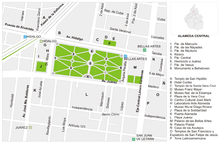- Mexico City Alameda Central
-
Alameda Central is a public municipal park in downtown Mexico City, adjacent to the Palacio de Bellas Artes, between Juarez Avenue and Hidalgo Avenue.
Contents
Description
The Alameda Central park is a green garden with paved paths and decorative fountains and statues, and is frequently the center of civic events. The area used to be an Aztec marketplace. The park was created in 1592, when Viceroy Luis de Velasco decided to create green space here as a public park. The name comes from the Spanish word álamo, which means poplar tree, that were planted here.[1] This park was part of the viceroy's plan to develop what was, at that time, the western edge of the city. It has become a symbol of a traditional Mexican park and many other parks in the country take on the name "Alameda" as well.[2]
History
The original park was less than half the size of the current one, reaching only from where the Palacio de Bellas Artes is now to the location of the Hemiciclo de Juárez. What is now the western section of the park originally was a plain plaza built during the Inquisition in Mexico and known as El Quemadero or The Burning Place. Here witches and others convicted by the Inquisitors were publicly burned at the stake. By the 1760s, the Inquisition has nearly come to an end and in 1770, viceroy Marqués de Croix had this plaza torn up to expand the park. The park was expanded again in 1791, when the Count of Revillagigedo built a wooden fence around the park to make it exclusive for the nobility. However, when Mexican Independence was won in 1821, the Alameda was the center of popular celebrations. In 1846, when President Santa Anna rode triumphantly into Mexico City, he ordered the fountains in the park be filled with alcohol.[2]
The five classical fountains are of French design and inspired by Greco-Roman mythology. More statues were added to the park in the 19th century. Gas lamps were installed in 1868, which were replaced by electrical lighting 1892. By the end of the 19th century, the park had become popular with all social classes in Mexico. Much of the current layout of the park, with its starburst pattern of paths around fountains and the central kiosk dates from the late 19th and early 20th centuries.[2]
By the late 19th century, the park included a bandstand and gas (now electric) lamps. On the south side of the park, facing toward the street is the Hemiciclo a Juárez, which is a large white semi-circular monument to Benito Juárez, who is one of Mexico's most beloved presidents.[1]
The park's statues include Despoire and Malgre Tout, by Jesús Contreras, and a monument donated by the German community which is dedicated to Beethoven in commemoration of the centenary of his 9th Symphony.
Access
Alameda Central can be accessed by Metro Bellas Artes.
References
Landmarks and historic buildings of Mexico City Centro Zócalo
and immediate vicinitySchools and colleges Universidad del Claustro de Sor Juana · Academia Mexicana de la Historia · Academy of San Carlos · Colegio de San Ignacio de Loyola Vizcaínas · Antigua Escuela de Economía · Colegio Nacional · Colegio de Minería
Government buildings Old Customs Building · Chamber of Deputies · Departamento de Estadistica Nacional · Secretariat of Public Education Main Headquarters · Senate building · Supreme Court building · Palace of the Marqués del Apartado · Library of the Congress of Mexico
Religious buildings Nuestra Señora de Loreto Church · Church of San Francisco · Church of Nuestra Señora de Valvanera · Church of San Bernardo · Ex Temple of Corpus Christi · La Enseñanza Church · La Merced Cloister · La Santisima Church · Temple and Ex-convent of Jesus Maria · Church of San Juan de Dios · Santa VeraCruz Church · Regina Coeli Church · Santa Teresa la Antigua · Temple of San Pablo el Nuevo · Church of Santo Domingo · Temple of Saint Augustine · Temple of San Felipe Neri "La Profesa" · Church of La Soledad
Museums San Ildefonso College · Caricature Museum · Franz Mayer Museum · Museum of the City of Mexico · Interactive Museum of Economics · Museo de Arte Popular · José Luis Cuevas Museum · Palace of the Inquisition (Museum of Mexican Medicine) · Mexican Army Museum · Museo Nacional de Arte · Museo de Charrería · Museo de la Estampa · Museo de Estanquillo · Museum Archive of Photography · Museum of Secretaría de Hacienda y Crédito Público · San Pedro y San Pablo College (Museum of Light) · House of the First Print Shop in the Americas · National Museum of Cultures · Borda House, Mexico City
Palaces Castillo de Chapultepec · Palace of Iturbide · Palacio de Bellas Artes · Palacio de Correos de Mexico · Casa de los Azulejos · Houses of the Mayorazgo de Guerrero · Palace of the Marqués del Apartado · Palacio de la Autónomia
Historic houses Tlaxcala House · House of Count de la Torre de Cossio · House of the Marquis of Uluapa · House of the Count de la Torre Cosío y la Cortina
Other Plaza Garibaldi · Antigua Escuela de Jurisprudencia · Chinatown (Barrio Chino) · Tlaxcala House · Garden of the Triple Alliance · Centro Cultural de España (Mexico City) · INAH Building · Abelardo L. Rodriguez Market · La Merced Market · Lirico Theatre · Alameda Park · Plaza Santo Domingo · Teatro Hidalgo · Teatro de la Ciudad · Torre Latinoamericana · Hospital de Jesús Nazareno · Tlaxcoaque
Coordinates: 19°26′08″N 99°08′38″W / 19.43556°N 99.14389°W
Categories:- Parks in Mexico City
- History of Mexico City
- 1592 establishments
- Aztec sites
- Colonial Mexico
- Gardens in Mexico
Wikimedia Foundation. 2010.



